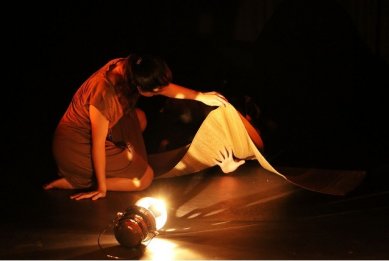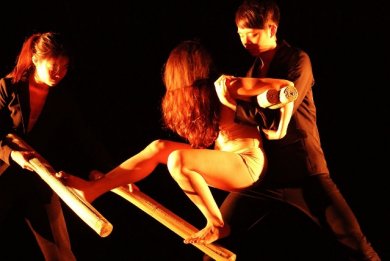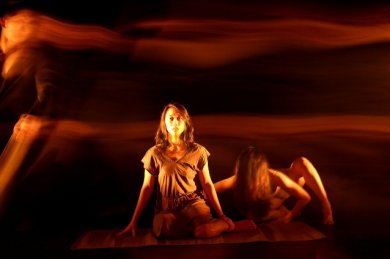
|   |

|   |
 e-mail: ukb7@rediffmail.com Traipsing into light September 14, 2016 While poets have waxed eloquent, “Life’s but an empty dream”, others have viewed dream as a succession of images, ideas, emotions, and sensations that occurs involuntarily in the mind during sleep. The content and purpose of dreams are certainly not understood, though they have been a topic of scientific scrutiny as well as subject of intense philosophical and religious speculation throughout recorded history. After Dark presented by Damansara Performing Arts Centre from Malaysia -- as the inaugural event of INTERFACE 2016 in Kolkata organized by Sapphire Creations under the able guidance of Sudarshan Chakravorty -- was spun around dreams. According to Wong Jyh Shyong (JS), the artistic director, “Dream is the metaphor of reality. In a dream or in reality, we keep waking up and falling asleep. There are moments when we are trying to stay awake and sometimes we would rather sleep. There are moments when we see nothing but hear everything. Thus, the more we can't see in the darkness, the more we dream…” 

In the all-enveloping darkness, the dance begins over the flicker of the kerosene lamp providing the end of the tunnel: as the sole source of hope swinging on the dark proscenium stage. Everyday life objects loom large: as the staple of both narration and imagination. The twisting and twirling figures appear to exist both in reality and in dream, but the choreography gradually veers towards “fear” as the common theme: in the form of emotion we all share, we are afraid of, and we always want to conquer. Even more slowly, straw mats emerge and dominate the now-oscillating kerosene light overhead: as sources of inspiration for the choreographic creation. There are multiple ways of playing with the mats, with which the dancers explore the theme of dreams and dreaming. They hide, wrap and weave in and out of the mats to create a dramatic and illusory scenario -- of being covered and uncovered, of being seen and disappearing unseen. The finale is an all-embracing vertical screen, hiding from sight the perceptible world of both reality and dreams. Excerpts from interview with the artistic director:  What’s your overall message? It is that there’s darkness in life, but there’s also the constant striving towards light. As a poetic term, I use ‘darkness’ to connote the presence of evil forces in life, such as wickedness, corruption, sinfulness, inequity, immorality, devilry and criminality. I present the journey of fighting against this darkness, with the belief that there always lingers light and hope on the other side. Do you expose your dancers to classical ballet? Yes, indeed. Half of their training is in classical ballet and the other half is in contemporary dance. But do you have our own method of training? Yes, we have evolved our own regimen of grooming and own grammar. All the dancers undergo that discipline. What have been the elements of your choreography? These are Tai-chi, martial arts, acrobatics and contemporary dance. These apart, there are tons of energy underneath everything! Talking of energy-level, what’s the average age of your dancers? Is it between 18 and 20? No, the average age is around 22, isn’t that wonderful?  Dr. Utpal K Banerjee is a scholar-commentator on performing arts over last four decades. He has authored 23 books on Indian art and culture, and 10 on Tagore studies. He served IGNCA as National Project Director, was a Tagore Research Scholar and is recipient of Padma Shri. Post your comments Please provide your name and email id when you use the Anonymous profile in the blog to post a comment. All appropriate comments posted with name & email id in the blog will also be featured in the site. |